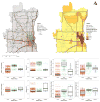Measures Matter: The Local Exposure/Isolation (LEx/Is) Metrics and Relationships between Local-Level Segregation and Breast Cancer Survival
- PMID: 28325737
- PMCID: PMC5380473
- DOI: 10.1158/1055-9965.EPI-16-0926
Measures Matter: The Local Exposure/Isolation (LEx/Is) Metrics and Relationships between Local-Level Segregation and Breast Cancer Survival
Abstract
Background: The Black-to-White disparity in breast cancer survival is increasing, and racial residential segregation is a potential driver for this trend. However, study findings have been mixed, and no study has comprehensively compared the effectiveness of different local-level segregation metrics in explaining cancer survival.Methods: We proposed a set of new local segregation metrics named local exposure and isolation (LEx/Is) and compared our new local isolation metric with two related metrics, the location quotient (LQ) and the index of concentration at extremes (ICE), across the 102 largest U.S. metropolitan areas. Then, using case data from the Milwaukee, WI, metropolitan area, we used proportional hazards models to explore associations between segregation and breast cancer survival.Results: Across the 102 metropolitan areas, the new local isolation metric was less skewed than the LQ or ICE. Across all races, Hispanic isolation was associated with poorer all-cause survival, and Hispanic LQ and Hispanic-White ICE were found to be associated with poorer survival for both breast cancer-specific and all-cause mortality. For Black patients, Black LQ was associated with lower all-cause mortality and Black local isolation was associated with reduced all-cause and breast cancer-specific mortality. ICE was found to suffer from high multicollinearity.Conclusions: Local segregation is associated with breast cancer survival, but associations varied based on patient race and metric employed.Impact: We highlight how selection of a segregation measure can alter study findings. These relationships need to be validated in other geographic areas. Cancer Epidemiol Biomarkers Prev; 26(4); 516-24. ©2017 AACRSee all the articles in this CEBP Focus section, "Geospatial Approaches to Cancer Control and Population Sciences."
©2017 American Association for Cancer Research.
Figures


References
-
- Denton NA. Half Empty or Half Full: Segregation and Segregated Neighborhoods 30 Years After the Fair Housing Act. Cityscape. 1999;4:107–22.
-
- Massey DS, Rothwell J, Domina T. The Changing Bases of Segregation in the United States. Ann Am Acad Pol Soc Sci [Internet] 2009;626:74–90. Available from: http://www.pubmedcentral.nih.gov/articlerender.fcgi?artid=3844132&tool=p.... - PMC - PubMed
-
- Frey WH. Census Data: Blacks and Hispanics Take Different Segregation Paths. Brookings [Internet] 2010 Available from: http://www.brookings.edu/research/opinions/2010/12/16-census-frey.
-
- Sudano JJ, Perzynski A, Wong DWS, Colabianchi N, Litaker D. Neighborhood racial residential segregation and changes in health or death among older adults. Heal Place [Internet] Elsevier. 2013;19:80–8. Available from: http://dx.doi.org/10.1016/j.healthplace.2012.09.015. - DOI - PMC - PubMed
-
- Williams DR. Race, Socioeconomic Status, and Health: Added Effects of Racism and Discrimination. In: Adler N, Marmot M, McEwen BS, Stewart J, editors. Socioeconmic Status Heal Ind Nations Soc Psychol Biol Pathways. Ann Arbor, Michigan: New York Academy of Science; 1999. pp. 173–88. - PubMed
Publication types
MeSH terms
Grants and funding
LinkOut - more resources
Full Text Sources
Other Literature Sources
Medical

